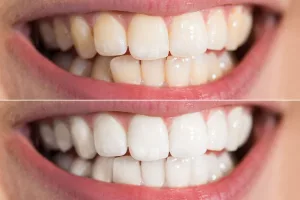You should consult your dentist before selecting a whitening treatment. This is because the cause of your stains and the type of stains matter in the selection process. Some whitening treatments work better than others. Additionally, you may find that a chemical whitening treatment isn’t right for you. Instead, you may need dental bonding, which is a process that camouflages the discoloration rather than breaking it down.

Internal and External Stains
When you think of stains on your teeth, you may think of ones that develop as a result of your diet or lifestyle. That is one type of stain. However, there are two types of stains—internal (intrinsic) and external (extrinsic).
Internal stains occur inside your tooth rather than on the surface. There are a number of ways these stains can happen, including antibiotic use. You can even develop internal stains on your teeth before they ever erupt from your gums. In addition, taking certain antibiotics before the age of eight can alter the enamel, leaving stains or white spots. Also, it is possible to inherit internal stains through genetics. Finally, trauma can cause intrinsic stains.
External stains develop through environmental factors, such as your diet or lifestyle. There are countless ways that your teeth can acquire stains. Smoking, coffee, wine, and artificial dyes are all things that can leave behind surface stains.
For every type of stain, there is a whitening treatment that can give you the bright smile you desire.
Professional Whitening
While there are many whitening treatments that you can do in the comfort of your own home, you may consider the efficiency of a professional whitening treatment.
Unlike at-home treatments, you will get immediate results when you visit your dentist. Many at-home whitening kits can take two to six weeks to see results. Additionally, professional whitening treatments produce better results. Finally, you will experience less gum sensitivity with a professional treatment.
Whitening Toothpaste
Whitening toothpaste uses bleaching chemicals, such as hydrogen peroxide, to break down the stains on your teeth. Additionally, many whitening toothpastes use mild abrasives to scrub the stains away.
Whitening toothpaste may take more time to see results compared to other treatments. You may use it to maintain the whiteness of your smile or gently whiten your teeth.
Trays/Gels/Strips
Other over-the-counter (OTC) treatments use the same bleaching chemicals as a whitening toothpaste. Therefore, it is essential to use whitening products as directed on the packaging. You may see quicker results with trays, gels, and strips compared to toothpaste, but they can cause sensitivity to your teeth and gums.
Dental Bonding
Dental bonding is a treatment that utilizes composite resin to alter the appearance of your teeth. Dentists can use bonding for both cosmetic and structural purposes. Frequently, dentists can use dental bonding to treat internal stains and extreme discoloration. In addition, for coloration issues that chemical whitening cannot solve, dental bonding camouflages severe problems.
Dental bonding is a quick and effective procedure that takes only one session. If traditional whitening treatments haven’t worked for you, you should talk to your dentist about dental bonding.
